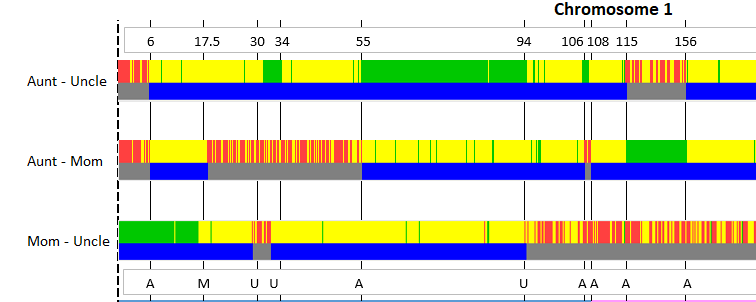If you have the possibility to test three full siblings, then the next great thing you could do with your DNA test results is to try out the Visual Phasing technique developed by Kathy Johnston. It allows you to map the segments of your chromosomes to your four grandparents (without having them or your parents tested) by comparing the recombination positions of the three siblings. However, to figure out which of your grandparents a segment belongs to, you will still need additional cousin testing on several of your lines. Ideally, multiple 2nd cousins on either side of your family, but more distant cousins have proved themselves to be very valuable as well.
I do not have full siblings, but luckily, both my mother and father do. I have tested my mother and my maternal uncle a few years ago, and when I first read about Visual Phasing on Blaine Bettinger’s fantastic blog, I immediately knew what I was going to do next – get a DNA test for my maternal aunt, too!
After meticulously studying Blaine’s instructions along with Ann Raymont’s, and rounding it all up by watching Lars Martin’s video on YouTube, I just couldn’t wait to put my newly acquired skills into practice.


Thank you so much for this article. It helped me understand the concepts of how to figure out how to match up the siblings. I have been struggling with this for weeks and since I read this, I have phased 10 of my chromosomes for three siblings already!! So glad I found this article! Thanks again!!
Thank you 🙂 Do you know about the automated Excel spreadsheet Steven Fox developed for Visual Phasing? It speeds up the mapping process a lot! You can download it from the Visual Phasing group on Facebook.
This was great – very easy to follow and great explanations
Once you have done this is there any way of recreating the dna of your grandparents and uploading it to Gedmatch of my heritage?
John
Thank you, John!
You can create an artificial DNA kit for your grandparents and then upload it to GEDmatch using one of Kevin Borland’s genetics tools. Once you have completed your VP project, you can enter the start and ending points of the segments of now fully phased chromosomes into DNAPainter, and that file will then be used in Kevin Borland’s tool. I haven’t done it myself as both of my Visual Phasing projects have not been fully completed yet – due to endogamy on my maternal side and due to the lack of cousins on my paternal side. So far I only used the Lazarus kit at Gedmatch to recreate data for both of my grandmothers, but I’m not fully satisfied yet.
Good Luck!